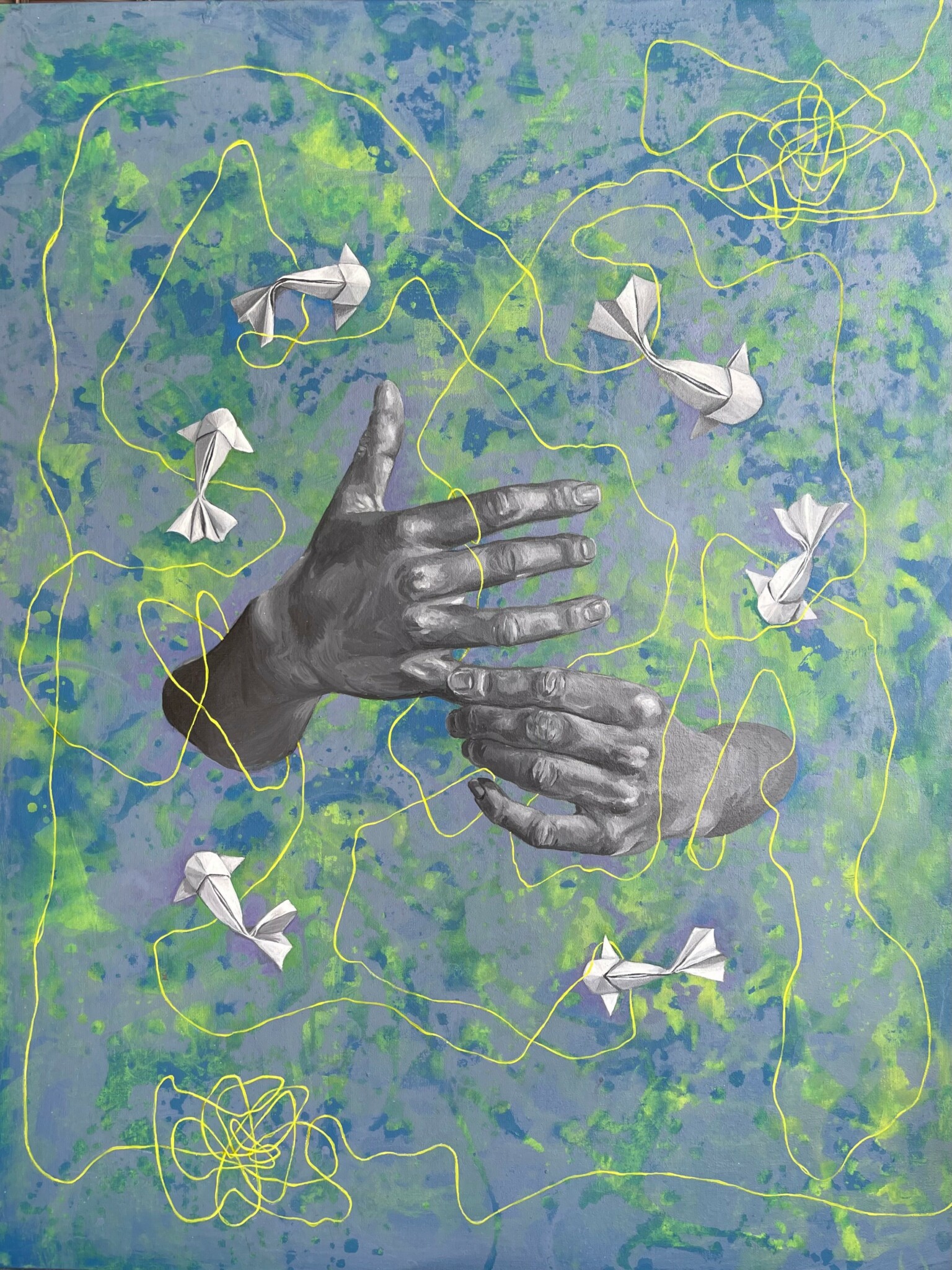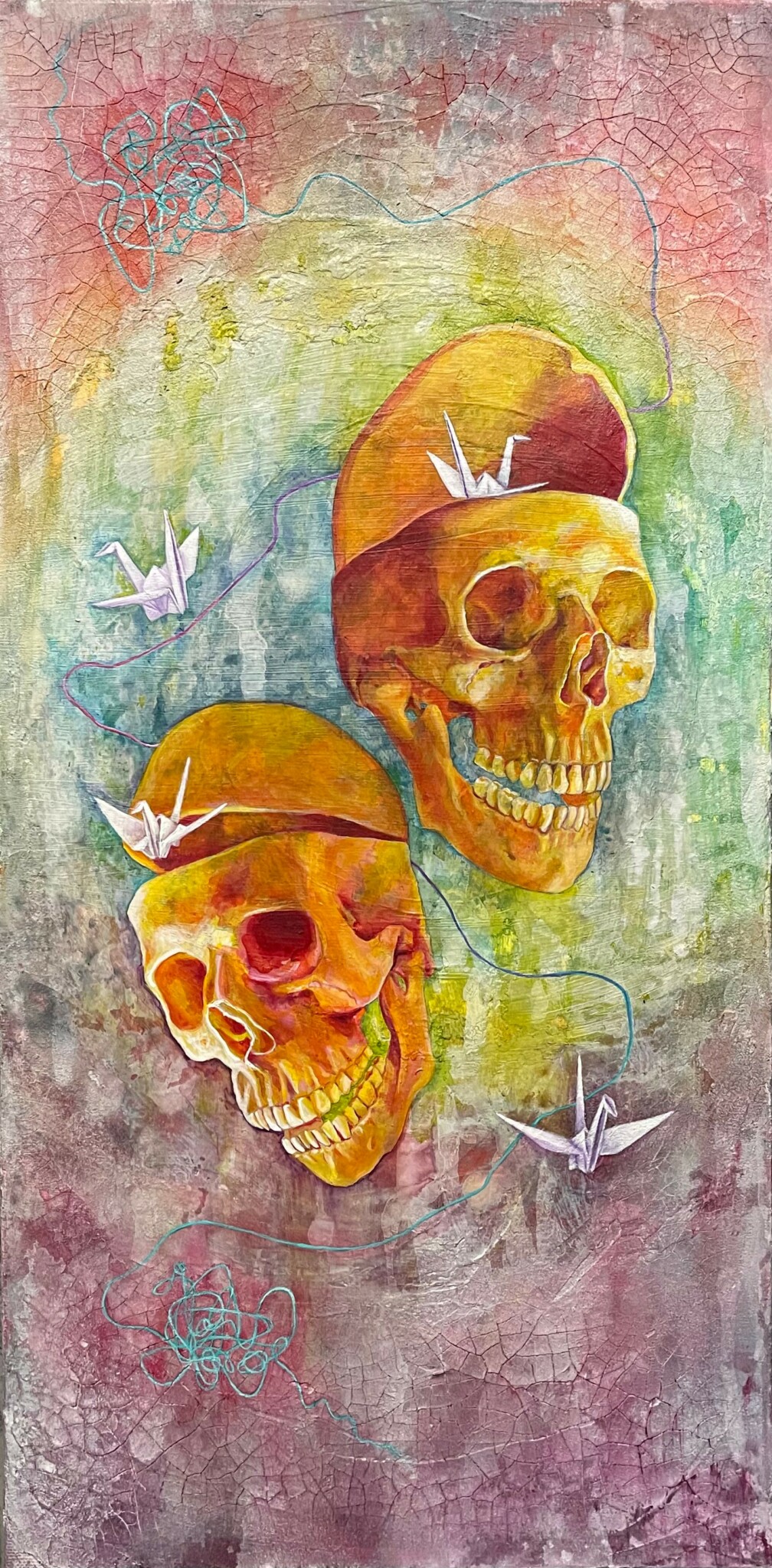We recently connected with Michelle Branson and have shared our conversation below.
Alright, Michelle thanks for taking the time to share your stories and insights with us today. Earning a full time living from one’s creative career can be incredibly difficult. Have you been able to do so and if so, can you share some of the key parts of your journey and any important advice or lessons that might help creatives who haven’t been able to yet?
You know what they say- ‘Those who can’t do, teach.” I’m pretty lucky in that I have almost always known I wanted to be a teacher. The thing that really stinks about this is that I guess I heard that saying one day and internalized it. I thought that teaching would just be my only art practice forever. That includes stuff like making examples and tutorials for my kids, completing the occasional project with them to show process, painting signs for whatever sport is happening, and that would be it. Honestly, it seemed like enough for a while because teaching is super demanding and you are capital T Tired at the end of the day. I loved my job though. I was obsessed with the town that I taught in and got super wrapped up in community projects. I volunteered my time and started an art club and a fine arts night for our elementary school with family activities and artists demos and a gallery portion that featured art from every single one of our students. I was fully engrossed in trying to be the best teacher I could possibly be. The universe decided to throw me a curve ball and my district switched around our schedules taking me out of my community. Then the universe apologized, and a position in the community I loved so much opened up. It was a highschool position so that meant one school, full time, and I had an entire art program all to myself. Now that I wasn’t traveling, I really was able to shape a program that I am still proud of to this day. My students won shows, passed difficult AP portfolios, and volunteered at elementary schools painting faces and assisted living facilities teaching painting classes. The job satisfaction was off the charts but the creative outlet was still missing. Teaching highschool students is such a gift for many reasons, but a big one is that it eventually encouraged me to focus on my own art practice. I was constantly encouraging these kids to find their own voice or style, create for the sake of creating, and to not be so scared of the word ‘no’ and eventually I just took my own advice. I had to realize that failure is necessary. If you want to put your vision out there, you can find a place, no matter how small you have to start. So, I started making work that was just for me. Then I ventured out and applied for Birmingham Art Walk. I tried to get into some shows and finally got a spot in one. Now I have the best of both worlds. I ended up making a move to a new high school closer to home last year, and the kids here are just as great and interesting and funny and challenging. I have a stable position with benefits doing what I love, but I also get a couple of months each year to prep for a few shows or festivals. It’s perfect.


Michelle, before we move on to more of these sorts of questions, can you take some time to bring our readers up to speed on you and what you do?
Whether it is in the classroom or at a show, I truly believe that learning about art is just like learning another language. It opens doors to communicate with other humans when that might not have been possible before. All of my personal work deals with trying to find aesthetically pleasing images using things that don’t sit easily in my mind or that wouldn’t be traditionally thought of as ‘pretty’. I usually combine portraiture and visual symbols that we associate with death and anxiety. I try to frame these combinations in a way that allows me to accept those things, or seeks connection with the viewer by visualizing abstract feelings or fears. Showing my work at an art walk and getting to talk to people who connect with my work is so necessary to my teaching and artistic practice. It keeps me passionate about my craft and helps me keep my technique sharp. It also offers me the opportunity to get to know new or emerging artists as well as people that are more established. The only thing I truly know is how incredibly much I don’t know and that frame of mind has led me to learn so many new techniques from other artists. I like to joke that my booth at Art Walk every year looks like an unhinged HomeGoods because there aren’t just paintings. It’s like a love letter to my ADD- There are pillows and small ceramics items and occasionally a rug or two. I think it is so important for my students to see me continuing to learn and change in my own artistic practice at 40. They need to see that this act of making art is a way to learn about others, learn about ourselves, or just create because we can, and that’s good enough. I think that whether it is in my classroom or at a show, I am always seeking connection and community. I feel like it is en vogue for art to be super cerebral but honestly, I think that what sets me apart from others is that I truly bring my art teacher energy with me even when I’m working outside of the classroom talking to people who are buying my art. I love talking about what I was going for, I love hearing what people see in my work, and I love encouraging people to find new local artists or just become one themselves.


How can we best help foster a strong, supportive environment for artists and creatives?
Society has a lot of heavy lifting to do to support artists and creatives. We have to make sure that people feel supported enough to be creative and make that next great thing. If everyone has 4 side hustles and no third space to exist in without having to spend money, life becomes about surviving, and I don’t think that this is actually conducive to being creative. I know that struggle can lead to great work. We get that archetype of the starving/tortured artist for a reason I’m sure, but I don’t think that this is the rule. I think it is the exception. What artistic potential or radical ideas burnt out before we as a society got a chance to see it because there was just no time or support for people who want to be creative but can’t? People have to have time to think, ponder, ruminate and observe to be creative. If your job is tied to your art, you may feel like you are required to focus on what sells and not what speaks to you. If you are a full time creative, you have to be a full time content creator at times or else your work gets lost in the shuffle. People are at their most creative when they are allowed to really live life. We need more maker spaces where people can jump into the process without the huge cost of entry. We as a society have a lot to do but it all starts with placing intrinsic value on the visual arts without focusing on the monetary value that it can bring in. I know this sounds idealistic, especially now as education, social programs and funding for the arts is under attack, but I think we can get there.


Is there something you think non-creatives will struggle to understand about your journey as a creative?
This kind of relates to the last question because I think the major misconception people have about the visual arts is that it is self indulgent or elitist. Training your brain by participation in the visual arts results in more aesthetically pleasing public spaces, it helps us as a society record or process current events, it affects how objects you use every day are designed. Almost every profession can benefit from creative or artistic thinking. Even if it just means that your next presentation is prettier to look at. Beyond that, art is an indefinable thing that can help us all gain a better idea of what it means to be human. I usually just sum up how I feel about art by relating it to music. Musical artists create things that speak to pretty much everyone on a level that can’t be overstated. It can almost seem magical. Like that song was written about your own personal joy or pain or journey. So, just because you might not be able to write or play a song like that, just because you aren’t ‘good’ at music, you would never think that means you can’t sing in your car or dance in your kitchen. So why do so many people feel that way about art? People say all the time, “I’m not good at painting and I’ll never be an artist so why should I try?” Because! Because it can bring you joy, or help you focus. Humans learn through play. Go craft! Go color! Go take a class and find out maybe you are ‘good’ at art and fill your house with landscapes you never even sell. I truly think it is good for the soul.
Contact Info:
- Website: https://michellebransonart.weebly.com/
- Instagram: Paper_Calamity




